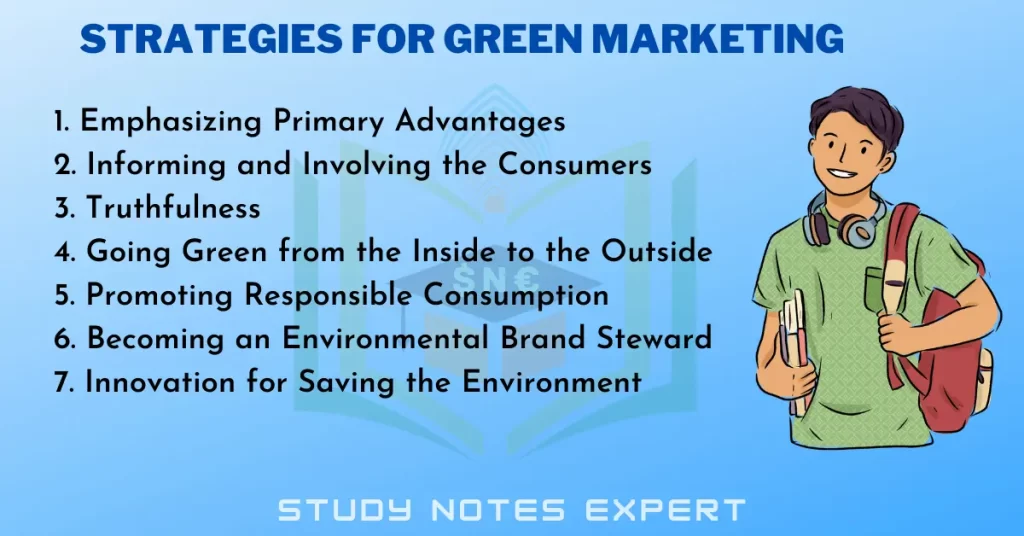The underlying assumption behind green marketing is to use the product’s greenness to influence buyers’ purchase decisions. Here, consumers perceive the naturalness of a product as a benefit. Marketers also assume consumers are ready to pay more specifically for green products than alternate ones. But this assumption still needs to be confirmed. The strategies for green marketing are necessary for the protection of the environment.
Fooling customers through offering non-green products as green is known as ‘green washing.’ Implemented appropriately, green marketing is a powerful marketing approach.
Techniques/Strategies for Green Marketing

Different strategies for green marketing are as follows:
1. Emphasizing Primary Advantages
Marketers should focus on something other than highlighting the green image of the product as consumers get exhausted with such claims. They are aware that these green images do not guarantee the natural content of the product. This is why it is essential to focus on the primary benefits derived from the product. Marketers should convey these benefits to market the products.
2. Informing and Involving the Consumers
Informing the consumers about the benefits of eco-friendly products is not simply telling about their ecological benefits, but rather it involves creating awareness about why it is essential to protect the environment. Without understanding, no one cares about green products, and the green marketing approach fails. This is one of the strategies for green marketing that helps in protection of the environment.
Allowing customers to give their opinion about a green approach would give them a sense of involvement, as they believe that by buying the product, they are doing their duty to save the environment. For example, if the customers are informed about the wrapper of a chocolate bar which could be easily decomposed without being harsh on the environment, the customer would have a sense of involvement in the campaign by buying the product.
3. Truthfulness
Truthfulness implies:
- The marketing approach should involve the actions which are stated.
- There should be consistency in the trade policies with the green marketing approach.
The green marketing approach campaign is successful with these steps.
4. Going Green from the Inside to the Outside
The campaign can succeed if the green approach is started from the inside, i.e., from producing the goods. The Green Effie award was created for the first time in 2008 to recognize the players who have played their roles in saving the environment. HSBC, Wal-Mart, and GE appeared as the semi-finalist in the nomination by citing examples from others.
For example, HSBC – “no small change” campaign, with the simple idea of authorizing people to do small things to reduce their carbon footprint. It is important to note that the HSBC campaign was carried out without offering carbon offsets to the customers. Instead, they supported strategies through which the bank can lower carbon consumption using renewable energy sources. The brochure to the customers also had various tips on reducing carbon footprints.
5. Promoting Responsible Consumption
One more strategy of green marketing is to encourage consumers for responsible and optimum consumption of natural resources. It includes offering LED lights to consumers with the advice of switching them off when not in use. This can also be achieved by using new technology and design in products. For example, auto-cut devices for water motor pumps switch off the motor when the tank is full.
6. Becoming an Environmental Brand Steward
Playing the role of a savior of the environment through the brand is important. This endeavor should be depicted at every stage of product manufacturing, from raw materials to production, using, and discarding. It would help recognize and suitably handle the influence on the environment.
For example, Proctor and Gamble identified that the domain is adversely affected due to incorrect washing of clothes in the machines (due to wastage of water, energy, and detergent) instead of manufacturing, transportation, or discarding a washing machine. From this idea emerged the concept of ‘Tide Cold Water.’
7. Innovation for Saving the Environment
This approach helps move the business by introducing innovation in the goods, technology, and raw materials; instead of refining the previous products. For example, CDs are replaced by iPods, traveling is replaced by video conferencing could help reduce carbon emissions, a detergent powder works without water (for counteracting water scarcity), etc.
Conclusion
This article will let you know that green marketing is helpful for business as well as for the environment. Green products are helpful for the environment because these are biodegradable and does not cause any harm to the environment. You will know the different strategies for green marketing that helps in maintaining the environment.

